The simple configuration of a transformerless power supply circuit presented below is able to provide high current at any assigned fixed voltage level. The idea seems to have solved the problem of deriving high current from capacitive power supplies which earlier seemed a difficult proposition.
Introduction
I have discussed a few transformerless power supply circuits in this blog which are good only with low power applications, and tend to become less effective or useless with high current loads.
The above concept utilizes high voltage PP capacitors for dropping the mains voltage to the required level, however it is unable to raise current levels as per any desired particular application.
Although, since the current is directly proportional to the reactance of the capacitors, means the current can be lifted just by incorporating more capacitors in parallel.
But this puts a risk of high initial surge currents which might destroy the involved electronic circuit instantly.
Adding Capacitors to Increase Current
Therefore adding capacitors might help to increase the current specs of such power supplies but the surge factor must be first taken care of for making the circuit feasible for practical usage.
The circuit of a high current transformerless power supply explained here hopefully, effectively handles the surge developing from power transients such that the output becomes free from the dangers, and provides the required current supply at the rated voltage levels.
Everything in the circuit is kept just as its old counterpart, barring the inclusion of the triac and zener network which actually is a crowbar network, used for grounding anything that goes above the rated voltage.
In this circuit the output would hopefully provide a stable voltage of around 12+ volts at around 500 mA of current without the dangers of any accidental voltage or current influx.
CAUTION: THE CIRCUIT IS NOT ISOLATED FROM MAINS AND THEREFORE INVOLVES HIGH RISK OF ELECTROCUTION, APPROPRIATE PRECAUTION NEEDS TO BE EXERCISED.

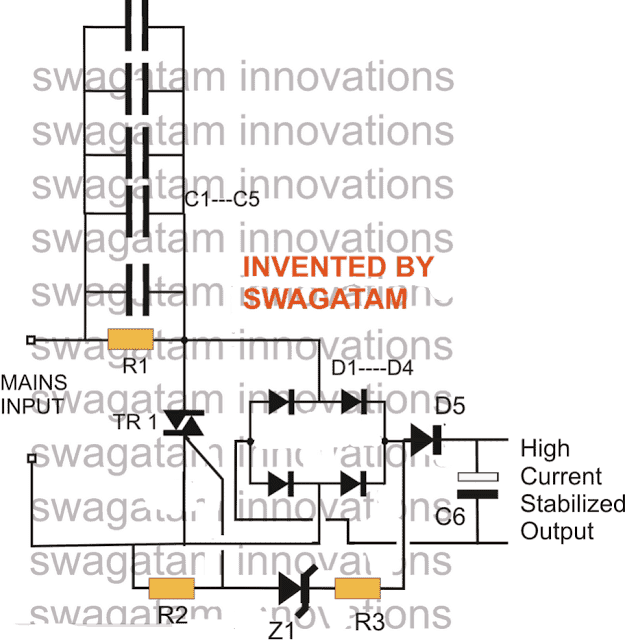
UPDATE: A better and a more advanced design can be learned in this zero crossing controlled surge free transformerless power supply circuit
Parts List
- R1 = 1M, 1/4W
- R2,R3 = 1K, 1/4 WATT
- C1----C5 = 2uF/400V PPC, EACH
- C6 = 100uF/25V
- All DIODES = 1N4007
- Z1 = 15V, 1 watt
- TRIAC = BT136
A neatly drawn PCB for the above high current transformerless power supply may be seen below, it was designed by Mr. Patrick Bruyn, one of the avid followers of this blog.
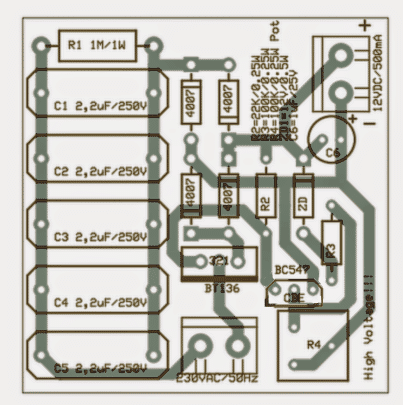
Update
A deeper analysis of the circuit showed that the triac was dumping a significant amount of current while restricting the surge and controlling the current.
The approach taken in the above circuit for controlling voltage and the surge is negative in terms of efficiency.
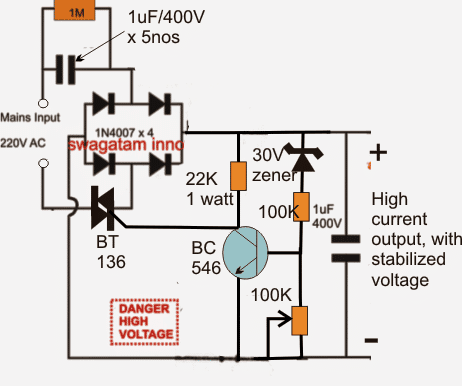
In order to obtain the intended results as proposed in the above design and without shunting precious amps, a circuit with exactly opposite response needs to be implemented, as shown above
Interestingly, here the triac is not configured to dump power rather it's wired in a such a way that it switches OFF power as soon as the output reaches the specified safe voltage limit, which is detected by the BJT stage.
New Update:
In the above modified design the triac may not conduct properly due to its rather awkward positioning.
The following diagram suggests a correctly configured version of the above, which can be expected to operate as per the expectations.
In this design we have incorporated an SCR instead of a triac since the positioning of the device is after the bridge rectifier and therefore the input is in the form of a DC ripples and not AC.
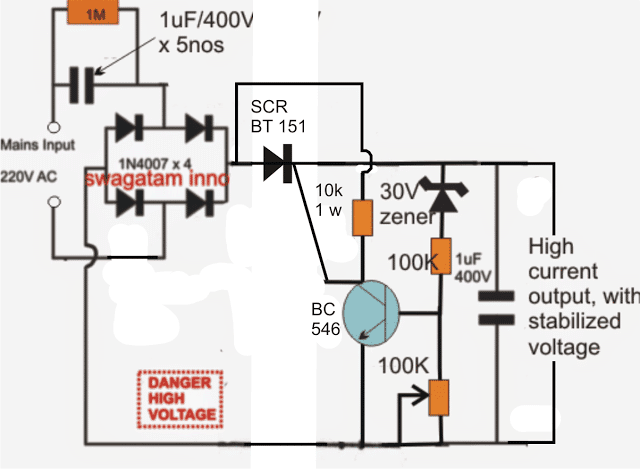
Improving the above design:
In the above SCR based transformerless power supply circuit, the output is surge protected through the SCR, but the BC546 is not protected.
In order to ensure a complete protection for the entire circuit along with the BC546 driver stage, a separate low power triggering stage needs to be added to the B546 stage. The amended design can be seen below:

The above design can be further improved by modifying the position of the SCR as shown below:
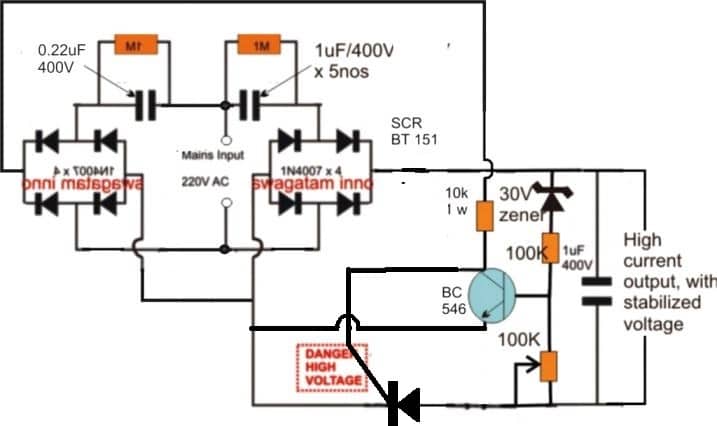
So far we studied a few transformerless power supply designs with high current specs, and also have learned regarding their different modes of configurations.
Below we would go a little farther and learn how to make a variable version circuit using an SCR. The explained design not only provides the option of getting a continuously variable output but is also surge protected, and therefore become much reliable with its intended functions.
The circuit can be understood from the following description:
Circuit Operation
The left side section of the circuit is quite familiar to us, the input capacitor along with the four diodes and the filter capacitor forms the parts of a common, unreliable fixed voltage transformerless power supply circuit.
The output from this section will be unstable, prone to surge currents, and relatively dangerous to operate sensitive electronic circuits.
The portion of the circuit on the right side of the fuse transforms it into a completely new, sophisticated design.
The Crowbar Network
It's in fact a crowbar network, introduced for some interesting functions.
The zener diode along with R1 and P1 forms a kind of voltage clamp which decides at what voltage level the SCR should fire.
P1 effectively varies the zener voltage from zero to its maximum rating, so here it an be assumed to be zero to 24V.
Depending upon this adjustment, the firing voltage of the SCR gets set.
Supposing P1 sets a 12V range for the SCR gate, as soon as mains power is switched ON, the rectified DC voltage starts developing across D1 and P1.
The moment it reaches the 12V mark, the SCR gets sufficient triggering voltage and instantly conducts, short circuiting the output terminals.
The short circuiting of the output tends to drop the voltage toward zero, however the moment the voltage drop goes below the set 12V mark, the SCR is inhibited from the required gate voltage and it reverts to it non conducting state.... the situation yet again allows the voltage to rise, and the SCR repeats the process making sure the voltage never goes above the set threshold.
The inclusion of the crowbar design also ensures a surge free output since the SCR never allows any surge to pass through to the output under all circumstances, and also allows relatively higher current operations.
Circuit Diagram
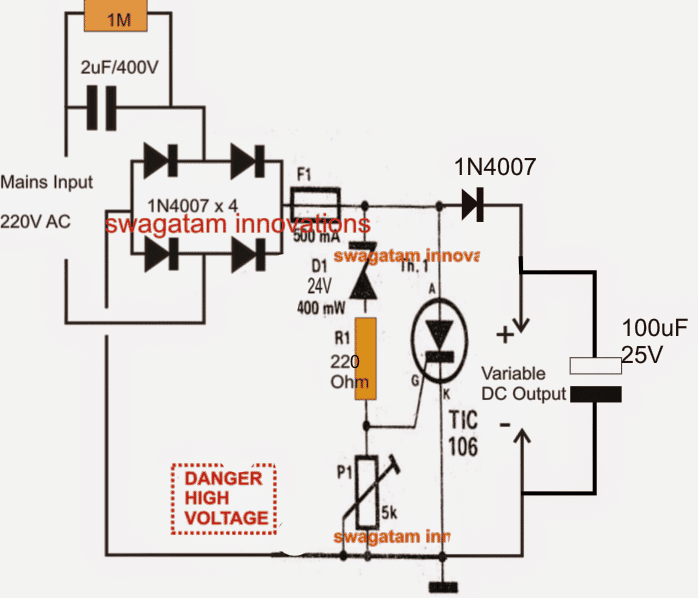
Another SCR based Circuit
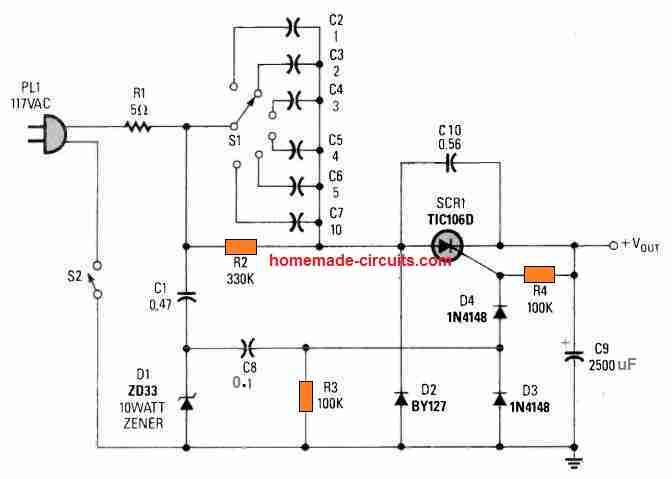
This SCR based high current Transformerless Power Supply consists of rather a few, easily accessible electronic parts.
The output voltage level (and also the level of feasible current as provided in the Table I) is adjustable by rotating the rotary switch S1.
Table#1
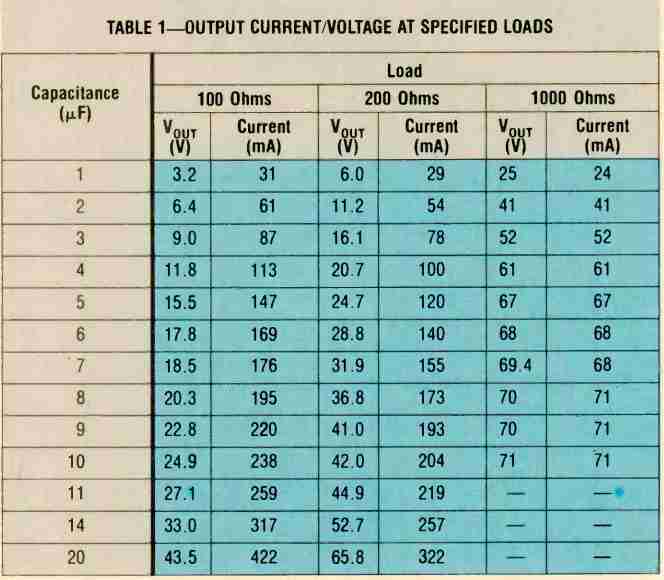
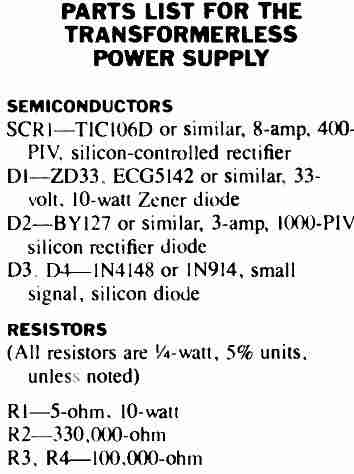
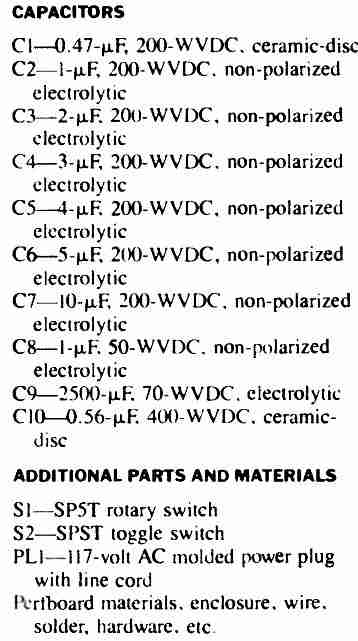
Zero Crossing Controlled High Current Transformerless Power Supply Circuit
The following circuit shows how a zero crossing concept can be implemented to create an effective transformerless high current power supply circuit, which is highly customizable.
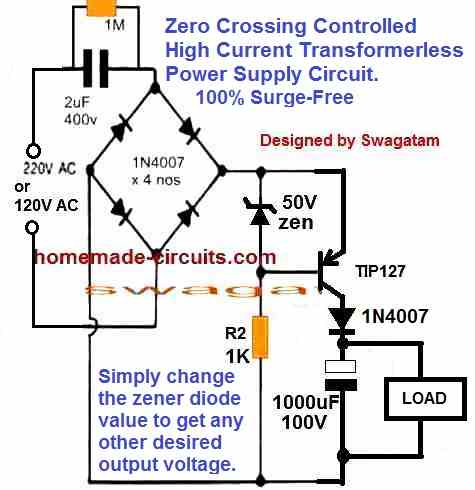
Advantages of this Circuit are as follows:
100% surge free ensures that the load, zener diode and the capacitor are completely safe all the time regardless of the input switching conditions of the power supply.
No heat dissipation ensures that the circuit's efficiency is maximum.
How the Circuit Works
We know that the main issue with transformerless power supply circuit is the switch ON surge current, which happens due to the sudden peak AC entering the electronic circuit connected with the power supply.
This sudden in-rush voltage and current leads to the burning of the vulnerable electronic components attached with the power supply.
This means that, if the load is allowed to be switched ON whenever the AC waveform nears the zero crossing then such mishaps can be avoided.
The above circuit does exactly this.
The PNP TIP127 conducts only when the AC waveform is below the zener value.
When the TIP127 conducts the AC waveform is already within the safe range of the load and this safe voltage gets stored in the 1000uF capacitor for powering the load.
The process continues for each cycle and only when the AC peak has dropped down safely to the zener value, which keeps the load powered consistently, with an optimized voltage and current inputs.

sir ,2 phase 415v ac to 190v dc 6amp power supply ckt diagram.
sreenivasulu, how many wires do you have in your two phase system, please clarify this, I will try to help!
Hi sir, I need an inverter circuit that I can use with 0-24v (10amp) transformer
Thanks Majaha, I will try to suggest a proper design for you soon.
Hi Mr Swagatam , firstly I want to thank and praise you for tutorials in electronics engineering, they are very helpful and understandable.I want a circuit for reducing 230v ac to 120v ac(2amps).Looking forward for your response.
Thank You Majaha, I appreciate your kind words.
You can simply use a transformer with 230V winding at the primary, and 120V winding at the secondary for the required conversions.
Hi Swagatam,
do you think the zero crossing version you posted can handle 48vdc @ 1A ? Considering input voltage is 110Vac. Also, should I increase the input capacitor value or can I leave 2uF?
Cheers
Hi Cheerios,
Yes TIP127 is rated at 5 amp 100v, so 48v, 1 amp is within its reach.
However, for 1 amp current the input capacitor will need to be rated at 20 uF/ 250v
Thanks for your reply, do you think is it possible to use smd ceramic capacitors ?
Yes, you can use 20uF 250v smd capacitor if that’s avaliable to you…
What is the maximum current that your final circuit can withstand in its current state without modification? I want to charge an 18650 battery with a current that does not exceed 250 milliamps. Is it suitable in its current state?
Thank you man.
The last circuit using tip127 can handle upto 2 amps, but I am not sure if tip127 is suitable for this application, if it burns please consider using a 400v pnp transistor.
I designed the last circuit as is, without change, and it works very well. I put a zener diode as you did, but the output voltage was 21 volts, so I had to put another 5.6 volt zener diode on the exit capacitor, so there were 2 zener diodes in the circuit, and the circuit actually worked very well. The battery was charged perfectly, noting that the exit capacitor is 2200u 25v. My question to you is: Why was the circuit exiting before the last zener diode was placed? Can I delete the first zeber and leave the last zener? Or leave the circuit as it is with 2 zener diodes?
That’s great Hima, Glad the last circuit is working for you.
Which zener diode did you use at the base of the TIP127?
I think if this zener diode is adjusted appropriately then the second zener diode across the output capacitor will not be required.
Can you please try different lower value zener diodes until you get the 5V at the output.
Otherwise you can also try using many 1N4148 diodes in series to create the intended, equivalent zener diode at the transistor base.
Let me know how it goes.
My dear brother, thank you for your quick response to my message. Firstly, the value of the zener on the gate of the transistor tip 127 is 5.1 volts, but unfortunately it did not work well in charging the battery, and since I combined with your circuit another circuit to cut off charge, it was necessary to add a zener of 5.6 volts for precise calibration to disconnect the battery charge when… Voltage 4.2. Indeed, the integration of the two circuits together was successful, and four different types of 18650 batteries were charged. The charging was also separated perfectly at voltage 4.2, and no part in the two circuits heated up at all. I would like to thank you very much for what you provided on this site. I have another question there. Noise at the ceramic input capacitor. Is there a solution or not?
No problem Hima, if two zener diodes are working good for you, you can keep them as is.
The ripple noise at the input side cannot be eliminated, because if you connect a filter capacitor that will cause the tip127 to switch off permanently and the circuit will not work.
Thank you dear, how much current is the last circuit?
Hello Hima, the current capacity of the last circuit will depend on the transistor current rating, with a TIP127 it can be around 2 amps.
Hi Swagatam!
I must say these articles are very helpful.
I needed your opinion on the following idea for building a high current transformer less power supply.
We design it in two stages. The first stage, is a low current stage which just generates enough power for a small, low-cost, microcontroller with an ADC.
In the second stage, this microcontroller using the ADC and a MOSFET … samples the input AC and disconnects the AC as soon as the voltage goes above say Xvolts and below 0V. So the AC waveform gets clipped and rectified at Xvolts positive to 0V. Then we use a smoothing capacitor to generate the DC we want by changing the value of X in the firmware.
Since the MOSFET is controlled by the microcontroller… it is never switched on above Xvolts … so the surge etc. are all handled adequately.
The point is .. one MOSFET that can handle, say, 200mA of current at 300V, and a small microcontroller are still much cheaper (and easily available) compared to components needed in a high-performance SMPS power supply.
I built and tested this circuit and it works … I am just wondering why it is not used so widely.
Thank you Vineet,
May I know what is the current and voltage outputs of the concept that you built? Can you build a 12 V, 5 amp design using your concept. So that is the actual challenge, building a high current low voltage power supply without involving a transformer.
Let me know your thoughts on this.
I earlier designed two power supplies using flyback switched mode transformer based power supplies for two different projects …
48V 2A for a telecom product4V 600mA for a metering productAt that time I did not focus too much on making them tranformer-less … but while I was validating these designs, I played around with the concept I discussed and it worked. However, I did not invest too much serious time on it then.
Now I need to mass-produce another product and I am seriously looking at using the concept I proposed. But needed your opinion on this before I start allocating resources to it. Can you think of any reason it would not work … so I can think of some way to design better before I ask my team to start prototyping.
The mosfet would turn on when the AC voltage is just zero crossing towards positive, so there would be no stress. There could be some risk that the mosfet would disconnect at X voltage …(say 12V) … but I think since we are using a 300V mosfet … it should not have a problem handling that.
Your proposed concept is supposed to work using a microcontroller and without a transformer. However without a transformer high current generation may not be possible? If you think generating high current is possible, I would be interested to know. According to me SMPS is the only way to transform high AC voltage to a low DC voltage with the desired high current, efficiently.
friend swagatam, I need a transformerless with a stable voltage output of 36 volts dc and amperes 1.5 amperes (in actual implementation it is only 495 milli amperes), is there a diagram above that I can apply?, and what components should I replace in the diagram above so that it can work I can use it, thanks for your attention.
Hi Sudarsono, you can perhaps try the following design:
https://www.homemade-circuits.com/wp-content/uploads/2013/05/surge-free-transformerless-power-supply-circuit-1.png
You can replace the 24V zener with a 36 V 1 watt zener diode and the 220 ohm resistor with a 1K 5 watt resistor. The SCR can be any 5 amp 400 V SCR. The capacitor on the mains AC side can be a 30uF/400V non-polar capacitor. However remember the SCR will get quite hot, that is the drawback of this kind of design.
how to overcome so that the scr is not too hot or becomes hot, thank you for the help, friend swagatam
The heat will depend on the input voltage and the output voltage difference. Since there’s a big difference between 36 V and 220 V, the heat will be also very high, there’s no way to reduce it.
Oky sir,
would you please help me with SMPS circuit which can output 12v at 20amps?
i, have freezing fridge which its power supply was burnt.
Godwin, I do not have a 12V 20 amp SMPS circuit. However, a 20 amp SMPS can be hugely complicated to build at home, so i would recommend you to buy it online which can be quite cheap and extremely efficient.
oky sir,
i, should explain it properly in this way;
as i keep it in mind, a transformerless produces a very low current in (milliamperes) not amperes. What i want is to modefy the circuit to drive 12v 20 amps loads purposes. If you can help this circuit, please present it to me immediately.
thanks,
Godwin.
Sure I understand, however 20 amp is actually too high. I wouldn’t recommend even 1 amp, because even at 1 amp the triac or the SCR can heat up a lot. SMPS is the best way to get a high amp output with max efficiency.
Oky sir,
by ignoring the relay at the ouput of the transformerless, should it be modefied by replacing the STTH600CW rectifier diode along with an inductor?
Godwin.
Hi Godwin,
sorry I could not understand how would you replace the relay with a STTH600CW diode and a coil, and for what for purpose?
Hi swagatam,
i thank you very much, for the work done day and night providing helpfull different circuits. I, Godwin, have benefit from these learning articles keep it on. Now coming to the topic; transformerless with high output current.
sir, my question is, is it possible to include a relay inorder to have high current?(2) and how? If yes, what are the cautions to this? Best regards
Godwin Shonga.
malawi.
Thank you Godwin,
I wouldn’t recommend more than 500 mA in a transformerless power supply circuit. Yes you can use a relay to switch a capacitive power supply as shown in the following example circuit:
https://www.homemade-circuits.com/wp-content/uploads/2022/02/capacitive-LED-driver-with-relay-for-preventing-switch-ON-surge.jpg
hello, i just want to know what the circuit would be for a 230vac to 60dc 10A power inverter in the same way as shown in the design pictures?
Hello, A capacitive concept cannot be used for currents over 200 mA. So for a 10 amp current you might need an SMPS circuit.
Hello Swagatam,
What do you mean by a SMPS circuit please?
The power supply has to be like and function as a transformer and need to be continious.
Like an IGBT welding machine but less complicated.
Hello Willem,
An SMPS is a switched mode power supply, as shown in the following images:
https://www.homemade-circuits.com/wp-content/uploads/2018/06/smps-flyback-design.jpg
Hi there
My Black & Decker heat gun just stop working and uses a seemingly simple 220V AC board to power a 12V DC (0.284A) motor for blowing the air and activate the heater. So far I have tested the triac and some other parts seems in working order. Could I email the picture of the circuit board so you might advise what component could be faulty.
Thanks
Hi, You can email me, I will try to solve it for you.
Hi Swagatam,
On the Crowbar Network, can I replace TIP106 by BT151, where gate current (Igt) is only 2mA? The zener & potensio which serially installed, are they affected by current through? By meant We can put any components regardless its staying power?
Thanks.
H Awak, yes BT151 can be used in place of TIP106. According to me the zener and the series resistor/pot are not affected by the current because as soon as the zener conducts the SCR fires and grounds the supply, so the affect of current on these parts are minimal.
Thanks for explanation. Here in my city, quite difficult to get 2uF 400V, if I replace with 1.5uF 400V, what resistor to replace 1M ohm?
Thanks.
Sure, 1.5uF will also do but will provide a maximum of 80 mA current output. The parallel resistor can be still 1 M, it is not critical since it is only used for discharging the capacitor whenever the power supply is unplugged from the mains.
Hi Swagatam;
I am having a 220vac / 9vdc unregulated adaptor 2amp output as printed on its body. I need to test the credibility of the output 2amp.
Would you recommend to shunt 4.5 ohm resistance across its output while measuring the output voltage. If it reads almost 9vdc, then it is a 2amp adaptor?
Hi Rezk, the easier option would be to connect a 10 amp ammeter directly across the adapter output for a couple of seconds, and check the reading on the meter. This would give you a quick and a reliable reading regarding the power supply output current.
Thanks…
Hi Swagatam,
I need a simple regulated & protected transformerless power supply 220VAC/1.5VDC-2 amp, will be used for a gas water heater ignition unit instead of 1.5v battery which depletes fast. I tried several 1.5vdc adaptors available in the market, yet they are either below capacity or does not work long & fails due to high amps needed.
I have seen several circuits, but most are below 2amp output.
Thanks…
H Rezk, transformerless power supply using capacitor at 2 amp current can be dangerous and is not recommended, and also it will be very inefficient at 1.5 V, therefore only SMPS is the recommended option
Thanks Swagatam, I will go for a transformer power supply & add an LM338 regulator.
Welcome for any comments.
You are welcome Rezk, that sounds much better!
Sir,
Can we achieve 12v 2Amp Output with that circuit by increasing capacitors?
or any another solution would you suggest which should be transformer less?
Hello Hafiz, 2 amp can be achieved but the triac may get very hot and waste a lot of energy, that is why an SMPS is always a recommended design instead of capacitive power supplies.
Hi Swagatam,
I use 24V batt for circuit trial up purpose on SCR BT151 circuit above, but the SCR is not triggered using 10K resistor, what suitable value to trigger the SCR? Any formula to calculate SCR gate resistor?
Thanks.
Hi Awak, In that case you can try reducing the 10K to 4k7 and see if that triggers the SCR. I do not have the formula in this website, however, you can refer to the triac concept, and deduce the formula accordingly:
https://www.homemade-circuits.com/triac-circuits-working-and-application/
I have already put in live the circuit & measure output side – without load – that is 245V max & 215V min. I don’t brave yet to put a load where I’m not sure what voltage the actual output is. Base on your design, what is output voltage for this built up circuit?
Thank you.
The output voltage must be equal to the zener diode value. If it is not as per the zener value, then something maybe wrong. Or you can put a 220V load such as a 220V led bulb and check the response
Hi swagatam long time havent mail
Any how your help if possible you can design a battery charger
Your transformerless is ideal
My input 380 to 400vac 3phase and output to 12vdc 12 to 30 amp .
Your is very good in my project which a 3phase 380 to 400 vac output thanks
Hi Sean, thank you very much for your kind words! However, I don’t think 30 amp may be feasible with the above explained circuits.
Happy and Very well thank you.. in your response…….
Your are amazing I am impress
Thanks for your talent continue your cool
Hi,
As above circuit which has 5 nos capacitor can handle 500mA, is it possible to reach 1000mA with 10 nos parallel capacitor? If so, any specific calculation for it?
Thank for answer.
Hi, for the first it is not recommended to increase current to 1 amp, or else the triac can get very hot….instead you can try the second concept and see how it performs….
by the way 5nos of 1uF capacitor in parallel will produce 250 mA current not 500 mA.
Hi
I have some AC led strip lights. They run off a small sealed power supply that provides 200 volt DC. The strip lights consume 18.5 mA per meter (they include current regulating resistors) and were sold in 50 meter lengths. ~1A per 50 meter reel. I have been cutting up these water proof strips and using them for the garden path. I would like to make some extra power supplies as I will end up with more sections of led that power supplies.
I had thought that a bridge rectifier with filtering capacitor would do, and to drop the voltage with voltage divider resistors but the power rating of the resistors seems rather high- a zener would have the same problem. Of course I could put many resistors in parallel, but I guess I must be doing something wrong, because the power supplies that come with the lights are very compact, so there must be an easy way to do this.
Anyway any help you can offer would be appreciated. At least if you can steer me in the right direction. I had thought to cut open one of the power supplies to see what is inside, but this will ruin the power supply and I do have enough already.
Thanks in Advance
Choga
Compact power supplies are mostly SMPS and isolated from mains AC, so they are not easy rather much complex to build. If you wan an easy option then you must go with iron core transformer based power supplies and use a 7812 IC for providing fixed regulated voltage to your 12V LED strips.
Hope this helps you! Feel free to ask if you further doubts
Hi,
First of all sorry for my bad english, i’m from Brazil and i’m trying to do my best to make sure you understand my question.
I’m using the HLK-PM01 power supply for a switching circuit with arduino uno, like lamps, low power consuption circuits (TV’s, routers, etc.) and i need this circuit to be smaller. I want to try the transformerlees power supply but i need 5 V 600 mA output, with 100-240 V input. With the solution you show above, can i replace it in my circuit?
Thanks in advance for your attention.
Best regards
Also, since i need to be smaller, i’ll try to make that with smd components, using the MB10F bridge rectifier
Hi, I think the following concept will suit your requirement better. The design explained in the above article may dissipate a lot of power.
https://www.homemade-circuits.com/220v-smps-cell-phone-charger-circuit/
Thank you very much
Hi,
Why cant we use a MOV upto a rated voltage instead of crowbar network.
MOVs are not designed for handling continuous current shunting, they are designed for occasional shunting of few milliseconds.
Hi! Mr. Swagatam
I have read many portions from your site Homemade circuits. My LED TL was not working, I checked and found all LED are working driver is not working, just changed main capacitor but it did not work. Then I connected it through one bridge diode ckt in series with 104J400v taken out of driver & 10 ohms in series and 100 mfd 100v on output of bridge connected to LED series. It worked but light is less then driver connected LED
It is not big matters I can just buy another TL which is only 260. My time is more on making ckt etc but do not understand what driver ckt do why direct ckt as above is not that good
I am 70+ now left electronics for sometime, mainly it is curiosity to know all this
Can you suggest any website where I can read working of circuit
Thanks and regards
Harmahendra
Hi Mr. Harmahendra, the trasformerless supply explained above and elsewhere are all good when correctly calculated with regard to the load, expect that these not isolated from mains and therefore prone to lethal electric shocks.
If you can provide the specifications of the LED, I’ll try to suggest a suitable driver circuit for you.
I just loved ur enthusiasm and knowledge, i just came to say keep going high do something very great for country and society with ur knowledge and work, im sure u will. God bless u.
Thank you very much, i appreciate your thoughts, and God bless you too!
Hello, it is helpful to me. Can you please help me to design transformerless 12V 5Amp power supply. Can i use above circuit ? Which component values i have to change ?
A compact 12V 5 amp power supply can be built using an SMPS only, no other method is recommended.
https://www.homemade-circuits.com/12v-5-amp-transformerless-battery/
Ok thanks for the reply.
hi swagatam,
i want the output of 5v 500mA dc. which is circuit is suitable to my application. what is the protection at input side (AC) if there is any voltage surges?
thanks for sharing your reserch document.
Hi Vamsi, you can try the first circuit from the following article:
https://www.homemade-circuits.com/how-to-make-led-bulb-circuit/
It has all the required protections
Hey Swagatam,
I am fascinated with the way you document and keep experimenting.
Thank you Anand.
Hi Swagatam
what is the highest capacity of this circuit i mean voltage and current wise???
can it supply 30v-5amp ?????
Hi shuvam, highest capacity will depend on the input capacitor value. 5 amp is possible.
Hi Swagatam
approximately which value of capacitor should i use??
And if i use this circuit instead of SMPS will there be any problem???
Hi Shuvam, this circuit should not be used for currents more than 500mA
Hi swagatam,
I have build a circuit using diode rectifier, 105j400v, 1M, 50E, 12v zener and 10uf capacitor for converting 220 VAC to 12v. But the output power is too low to make the board run after assembly. I am looking for a solution to convert AC to 12v 300-400mA.
Please help me out in solving this.
Hi Bharath, 105 capacitor will only produce around 50mA current, so to get 300mA you may have to use around 7nos of 105 caps in parallel, also please reduce the 50 ohms to 5 ohms so that current is not dissipated by much.
Good day Sir. I really need to thank you for this educational information.
I want to build a relay circuit that can be power on by a single push button. Press once, it power “ON” the relay and second press, will power “OFF” the relay. The circuit can be powered by a 5V or a 12V power supply.
Thanks so much
Thank you Elvis, you can try one of the circuits presented in the following article
https://www.homemade-circuits.com/build-these-simple-flip-flop-circuits/
hello,
i wanted to build a 5V, 5A rectified circuit. could you please suggest me the proper circuit diagram
Getting 5V 5A from 220V mains will require an SMPS design. here’s one design which you can try:
https://www.homemade-circuits.com/12v-5-amp-transformerless-battery/
the 12v can be changed to 5V by adjusting the feedback zener diode and the secondary winding
I want to build a 12V, 1A capacitor power supply. Can you suggest an efficient circuit diagram. Thanks in advance.
Hi, The second last diagram in the above article is an efficient design which you can try!!
Hi Swagatam,
I’m also an electronic entrepreneur with similar passion what you have. Thanks for all your efforts so far. I’ve been referring to your circuits for more than 8 years now. I have a question though.
Is there a way to derive 5V, 150mA current to drive a 5V sugar cube relay from mains? And this time, it is not 220v-neutral, but i want to step down 2 phases – 440v (2 out of 3 phase AC mains input) to 5V.
Also, the work is with 3 phase AC input without neutral. I tried all options before reaching out to internet.
Any thoughts?
Thank you Vinay, Glad to have a dedicated reader like you!
You can use the earthing line as the neutral and use any one of the 3 phase lines as the phase, this will solve the problem quickly, otherwise it can be a bit complex.
You can use a spare mobile charger for this and use its output for driving the relay.
Let me know if it is favorable to you, or if you prefer the other complex method.
Thank you for the prompt response, Swagatam.
I dont want to use the earth line, as its failure may cause the panel to give out a shock.
All these days – i think i’ve tried most of the options and i understand more deeper into it.
Instead of using a relay, i wanted to trigger the load using a triac so that the relay coil current can be drastically reduced. However, i was informed that there is no availability of X2 capacitor for 440v AC to connect in series to use in a transformerless power supply. Hence i’m stuck there now.
Vinay, you can try putting 1uF/600 on each phase and terminate the ends with a 3 phase bridge rectifier, then connect the relay coil at the positive and negative ends of the bridge. This will do the job according to me.
Thanks for the inputs. Let me check that out, and update you back here. 🙂
No problems 🙂
Hey There..!
I was making an IoT project for which I needed a Lightweight, small sized power supply.
So, I chose to use a Transformerless Power Supply but I am confused with its current ratings. I need 5V 3A max output from the supply. What components do I choose..?
Hi, I won’t recommend a capacitive power supply if the current is as high as 3 amps. Moreover the design won’t be isolated from the mains and therefore can be too risky. So, You must go for an SMPS according to me.
Dear sir,
I would like to assemble a air cooler using 12 peltier modules. Instead of feeding tec1 -12706 with 12v 72amps, I would like to connect them in series with an input of 144v dc 6amps. For this, I tried a halfwave rectifier and a smoothing capacitor of 400v 1000mfd.
As per calculation, the dc output would be 240*0.5*1.414=169v. But I am getting about 340v with no load and 300v with a load of 2amps.
Kindly suggest a solution as to how can I obtain 110-120v dc from the mains with current output of 6 amps
Dear Shivakumar, even with a single diode half wave rectification, the peak voltage will be 310V, and this will be stored and sent back to the load from the filter capacitor, and therefore you will always see a 310V at the output.
if you remove the filter capacitor then the meter will show 120V, but still the peaks will be 300V, which can be dangerous for a 120V load.
To solve this you may have to use more devices in series so that it works with 300V DC or use a transformer for stepping it down
Thanks Swag
I will try this circuit and give my feedback
you are welcome!
Dear Swag,
This is regarding your second upgrade (the third diagram above)
What is the purpose of 10K 1W resistor connected between the anode of BT 151 and the junction of the collector of BC 546 & the gate of BT 151?
In fact, I tried this circuit. But the said resister is getting heated. What may be the reason?
Thanks in advance
Hi Nirmal, it provides the gate triggering voltage to the SCR. You can try increasing its value to 22K and see if that still allows the SCR firing comfortably…
Dear Swag,
I replaced 10K with 22 K 1W, but still it gets heated up and I also noticed failure of BC 546, three times.
Actually I am new to transformer less power supply circuits. So, I would like to know in detail how the circuit BT 151, 10K (22K) 1W resister, BC 546, Zener and the two resisters at base of BC 546 controls surge and voltage.
Thanks,
Dear Nirmal, the output is protected from surge because the output voltage is never allowed to increase above the selected zener value. The moment output level tries to go beyond the zener level, the SCR is switched OFF by the BC546 preventing the voltage to rise any further, conversely as soon as the SCR is switched OFF the output voltage is cut off which switches off the zener and BC546, switching ON the SCR and restoring power.
But the BC546 may not be protected from high voltage so this will need a separate protection circuit, I’ll try to update it soon…
Thank you Swag.
Hi Nirmal,
I have updated the diagram, please check it.